Dear All Near and Far,
I hope you have all been happy and healthy. I’m writing to you all from Ka-Nying Shedrup Ling Monastery where at present we are performing the annual Tsekar (White Amitayus/Buddha of Longevity) Drupchen (great accomplishment), a nine day ceremony based on a collection of liturgies belonging to the “Great Accomplishment Group Sadhana of White Amitayus”. This drupchen beginning on the 8th day of the fist lunar month of the Tibetan New Year brings forth auspicious circumstances for the practitioners two fold attainment of longevity and primordial wisdom.
When talking about auspicious circumstances for practitioners, the most perfect circumstance for realizing the correct view of emptiness is through generating complete non judgmental and genuine devotion to all the enlightened ones and to cultivate unbound and un fabricated compassion for all sentient beings. Some of you may be practitioners, some interested in practicing and some just receiving this message as a junk, to which I deeply apologize. For you practitioners and for those who are interested in practicing, when you do the practice, you need to have a certain goal or a boundary or a limit to where you want to reach. As mentioned countless times in my previous notes, devotion is key. For devotion, you need to have unerring certainty in the dharma, grounded pure perception, and finally heartfelt kindness of the teachers and the teachings. With these intact, devotion will naturally arise. In the moment of devotion, we should sincerely bring to mind our root gurus along with the lineage gurus and think of their great qualities and with great admiration, supplicate to them. Knowing that it is only through the kindness of the gurus that we’ll be able to understand the ultimate nature of the mind, with such great gratitude, genuine devotion should naturally arise. Devotion should be applied through supplication; physically through putting your palms together, verbally through chanting the supplication, and mentally by aspiring to become a good practitioner in any condition whether in happiness or in sorrow. Your devotion shouldn’t be judgmental as well. If it is, then your devotion is not pure. Devotion is actually a measurement of how deep your understanding of your realization of emptiness is.
Although all sentient beings possess the self existing wisdom, they are unaware of it and as a result beaten relentlessly in the illusory experiences of samsara and suffer tremendously. When seeing such, one should overcome with great compassion and pity. At a moment like this, one should genuinely aspire with great compassion for all sentient beings to be free from suffering and the cause of suffering. Compassion should be without bounds, without attachment, without judgement, without hope and well grounded.
On this 10th day of the first month of the Iron Rabbit Year, Guru Rinpoche renounces his kingdom, practices yoga and meditation in the great charnel ground of Sitavana and attains liberation. Gathering under the matrikas and dakinis, he is known as Guru Shantarakshita.
Keeping you all in my mind on this auspicious day of the auspicious month of the auspicious year!
Sarva Mangalam,
Phakchok Rinpoche
There will be a Phowa (ejection of consciousness) retreat by HE. Chokling Rinpoche and HH. Phakchok Rinpoche. The retreat is going to be in Johor Bahru, Malaysia. (NOTE: limited places available, please book ASAP).
This profound Phowa skillful mean will enable us to directly transfer our own consciousness at the point of death to Amitabha Buddha’s Sukhavati, the Western Pure Land of Great Bliss. This immensely beneficial practice is highly regarded because of its conciseness, ease of practice, and ability to liberate us in an instant despite our heavy negative karma and disturbing emotions. Even if we do not become liberated immediately, at the very least, this extraordinary practice will ensure that after we die we shall obtain the precious bodies of gods or humans endowed with the freedom and fortune to continue our spiritual path uninterrupted by the negative karmic ripening of lower rebirths.
การถ่ายจิตสู่ดินแดนแห่งพระอมิตาภะพุทธเจ้า (แดนสุขาวดี)
การปฏิบัติโพวานั้นจะทำให้เราสามารถถ่ายโอนจิตในเวลาแห่งการตายไปสู่ดินแดนสุขาวดี แห่ง พระอมิตาภะพุทธเจ้า ในทิศตะวันตกซึ่งเป็นดินแดนแห่งทิพสุข การปฏิบัติโพวานั้นมีประโยชน์อันยิ่งใหญ่เพราะมีความชัดเจน ความสะดวกในการปฏิบัติ และ มีพลังที่จะสามารถผลักดันให้เราหลุดพ้นในทันที แม้ว่าเราจะสะสมอกุศลกรรมและมีความรู้สึกที่รุมเร้าเป็นอย่างมาก ถึงแม้หากจะเราไม่หลุดพ้น การปฏิบัติที่พิเศษนี้จะทำให้เราได้จุติเป็นเทวดาหรือมนุษย์ซึ่งจะมาพร้อมด้วยความอิสระและวาสนาในการที่จะปฏิบัติธรรมต่อไปโดยไม่โดนขัดด้วยการไปจุติในภพล่าง
Read the rest of this entry/อ่านรายละเอียด »
Dear Friends, Near and Far,
Greetings to you all from Nagi Gonpa, the nunnery and hermitage nestled in the serene Shivapuri Mountain of the Kathmandu Valley. Presently at Nagi, we have Chokyi Nyima Rinpoche, Tsikey Chokling Rinpoche and Yangsi Tulku Urgyen Rinpoche all engaged in the yearly nine day Ngakso Drupchen. Ngakso or Ngak kyi Sojong is a Vajrayana practice of mending and purification. Tulku Urgyen Rinpoche explained that in the Ngak kyi Sojong, we are mending and restoring the commitments of the vows of the individual liberation in accordance with the Hinayana system, the bodhisattva trainings, in accordance with the Mahayana system, and the samaya commitments, in accordance with the Vajrayana system. And in terms of the purification, Read the rest of this entry/อ่านรายละเอียด »
Photos from Ringu Tulku Rinpoche visit to Bangkok in January 2011
ภาพถ่ายจากงานบรรยายต่างๆในกรุงเทพฯ ของ ริงกุ ทุลกุ ริมโปเช ในเดือน กุมภาพันธ์ 2554
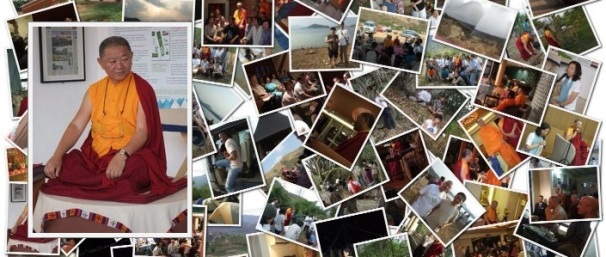
Photos from HH. Phakchok Rinpoche visit to Bangkok in January 2011
ภาพถ่ายจากงานบรรยายต่างๆในกรุงเทพฯ ของสมเด็จพักชก ริมโปเช ในเดือน มกราคม 2554
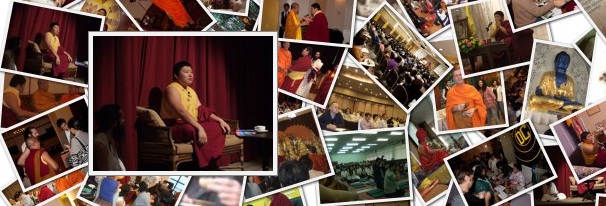
 This February 2011 well known Tibetan meditation master, Abbot, professor and writer Ringu Tulku Rinpoche will be teaching at various venues around Thailand. Be sure not to miss this eminent teacher who is well known for his erudition and excellent communication in English.
This February 2011 well known Tibetan meditation master, Abbot, professor and writer Ringu Tulku Rinpoche will be teaching at various venues around Thailand. Be sure not to miss this eminent teacher who is well known for his erudition and excellent communication in English.
ริงกุ ทุลกุ ริมโปเช บรรยายธรรม 2-15 กุมภาพันธ์ Ringu Tulku Rinpoche Dharma talk 2-15 February
รายละเอียดเพิ่มเติม/additional information please check: http://littlebang.org/2011/01/13/ringu-tulku-rinpoche-bkk-feb-2011/
ริงกุ ทุลกุ รินโปเช เกิดปี 1952 ที่แคว้นขาม ในทิเบตตะวันออก ได้รับการสั่งสอนจากพระอาจารย์ที่ยิ่งใหญ่แห่งศตวรรษที่ 16 ได้แก่ HH the 16th Gyalwang Karmapa and HH Dilgo Khentse Rinpoche และได้ศึกษาที่สถาบันนัมกยัล ที่มีชื่อเสียงของโลกที่สนับสนุนให้นักวิจัยสนใจศิลปะและวัฒนธรรมทิเบต และที่มหาวิทยาลัยสัมปุระนานันด์สันสกฤต ท่านได้เดินทางไปสอนพระพุทธศาสนาและการนั่งสมาธิที่มหาวิทยาลัยและศูนย์ปฏิบัติธรรมต่างๆ ในยุโรป สหรัฐอเมริกา แคนาดา และเอเชีย ท่านยังแต่งหนังสือพระพุทธศาสนาทั้งในภาษาทิเบตและยุโรปอีกด้วย
Ringu Tulku Rinpoche is a Tibetan Buddhist Master of the Kagyu Order. He was trained in all schools of Tibetan Buddhism under many great masters including HH the 16th Gyalwang Karmapa and HH Dilgo Khentse Rinpoche. He took his formal education at Namgyal Institute of Tibetology, Sikkim and Sampurnananda Sanskrit University, Varanasi, India and has served as Tibetan Textbook Writer and Professor of Tibetan Studies in Sikkim for 25 years.
Since 1990 he has been travelling and teaching Buddhism and Meditation at Universities, Institutes and Buddhist Centers in Europe, USA, Canada, Australia and Asia. He also participates in various interfaith and Science and Buddhist dialogues. He authored several books on Buddhism as well as some children’s books both in Tibetan and European languages.
—
วันพุธที่ 2 กุมภาพันธ์ 2554, 17.30-20.00 น. ธรรมบรรยาย “ศิลปะแห่งความสุข” (มีแปลไทย)
ณ สวนโมกข์กรุงเทพ (หอจดหมายเหตุพุทธทาส อินทปัญโญ) ข้างสวนรถไฟ ใกล้สถานีรถไฟฟ้าบีทีเอส หมอชิต
แปลไทยโดย รศ.ดร. กฤษดาวรรณ หงศ์ลดารมภ์
Wednesday February 2nd, at 5:30pm – 8:00pm Dharma Talk on “The Art of Happiness” , talk will be in English with Thai translation
Venue: Buddhadasa Indapanno Archives (BIA), Suan Mok Krunthep, next to Mo-chit BTS station
วันพฤหัสบดีที่ 3 กุมภาพันธ์ 2554, 18.30-20.30 น. ธรรมบรรยาย “อริยะสัจจ์ ๔ – จากมุมมองของวัชรยาน” (ไม่มีแปลไทย)
ณ หอประชุมพุทธคยา อาคารอัมรินทร์พลาซ่า (สี่แยกราชประสงค์ – บีทีเอสชิดลม) ชั้น 22 ถ.เพลินจิต
Thursday February 3rd, at 6:30pm – 8:30pm Dharma Talk on “The Four Noble Truths – a Vajrayana Perspective” , talk will be in English only
Venue: DMG Bodhgaya Hall, Amarin Plaza 22nd floor (Chit Lom BTS)
วันจันทร์ที่ 7 กุมภาพันธ์ 2554, 19.00-21.30 น. ธรรมบรรยาย “คำแนะนำสู่การปฏิบัติ มหามุทรา” (ไม่มีแปลไทย)
ณ ศูนย์ชัมบาละ ถนน นราธิวาสฯ ซอย 15 ต้องจองล่วงหน้า http://bangkok.shambhala.info 02 788 7488
Monday February 7th, at 7:00pm – 9:00pm Dharma Talk on “An Introduction to Mahamudra” , talk will be in English only
Venue: Bangkok Shambhala group, Naratiwat rd., Soi 15, near Sathorn
Reservation required, please check http://bangkok.shambhala.info or call Jamie on: 02 788 7488
วันอังคารที่ 8 กุมภาพันธ์ 2554, 10.00-13.00 น. ธรรมบรรยาย “การปฏบัติสมาธิ สุญญตา (ความว่าง)” (ไม่มีแปลไทย)
ณ อาคาร เวลคัม ถนน นเรศ บางรัก ต้องจองล่วงหน้า 081 9855564
Tuesday February 8th, at 10:00am-1:00pm Dharma Talk and meditation on “Emptiness” , talk will be in English only
Venue: Ram’s place near Sam Yan MRT/Subway station in Bangkok followed by lunch together provided from 13.00 free of charge
Reservation required, call Ram 081 985 5564
วันอังคารที่ 8 กุมภาพันธ์ 2554, 18.30-20.30 น. ธรรมบรรยาย “ความโง่เขลาในสังสารวัฏ” (ไม่มีแปลไทย)
ณ ศูนย์เต้นรำ สุขุทวิทย์ ซอย 24
Tuesday February 8th , at 6:30pm – 8:30pm Dharma Talk on “The Foolishness of Samsara” , talk will be in English only
Venue: Dance Centre, Sukhumvit 24, Bangkok
วันพุธที่ 9 กุมภาพันธ์ 2554, 18.00-20.30 น. ธรรมบรรยาย “การก้าวพ้นจากความดึงดูดของสังสารวัฏ” (มีแปลไทย)
ณ หอประชุมพุทธคยา อาคารอัมรินทร์พลาซ่า (สี่แยกราชประสงค์ – บีทีเอสชิดลม) ชั้น 22 ถ.เพลินจิต
Wednesday 9th, at 6:00pm – 8:30pm “How to Transcend the attractions of Samsara” , talk will be in English with Thai translation
(6:00 pm Chanting, followed by talk, short meditation and offerings)
Venue: DMG Bodhgaya Hall, Amarin Plaza 22nd floor (Chit Lom BTS)
วันพฤหัสบดีที่ 10 กุมภาพันธ์ 2554, 19.00-21.00 น. ธรรมบรรยาย “ยานทั้งสามในพุทธศาสนา – ความแตกต่างที่เหมือนกัน” (ไม่มีแปลไทย)
ณ สยามสมาคม ใกล้สถานีรถไฟฟ้าบีทีเอส อโศก, สถานีรถไฟฟ้าใต้ดินสุขุมวิท (มีค่าใช้จ่าย 200 บาทสำหรับผู้ที่ไม่เป็นสมาชิกสมาคม)
Thursday 10th, 7:00pm – 9:00pm Dharma Talk on “The Three Buddhist Yanas – how they are different, yet all the same” , talk will be in English only
Venue: Siam Society, Asoke intersection near BTS/MRT Asoke station (200 baht cover charge for non-members of Siam Soc.)
วันอังคารที่ 15 กุมภาพันธ์ 2554, 18.30-20.30 น. ธรรมบรรยาย “การตายอย่างสงบ” (ไม่มีแปลไทย)
ณ โรงแรมอริยสมวิลล่า สุขุมวิทย์ ซอย 1
Tuesday 15th February, 6:30pm – 8:30pm Dharma Talk on “Dying Gracefully” , talk will be in English only
Venue: Ariyasom Villa Boutique Hotel
You can find more information here:
http://littlebang.org/2011/01/13/ringu-tulku-rinpoche-bkk-feb-2011/
Dear Friends,
I hope you’ve all been happy and healthy. This being the first Guru Rinpoche Day message of the year 2011, and to start off the year auspiciously, I would like to share with you the Five Unshakeable Fortresses that is key for all dharma practitioners.
The Five Unshakeable Fortresses:
The five fortresses are extremely important for all dharma practitioners. If you don’t have these five, then actually it means that you are not doing quite so well…
1. Gaining Certainty in the View
Many of us when practicing the dharma are so busy doing things, physically, in the dharma world. Such as offering butter lamps, doing circumambulations, reading many texts, doing a lot of different daily practices, and while doing so, our precious time runs out. Though the time is not wasted on doing something unnecessary, but while engaging in doing these “dharmic activity”, we sometimes loose the focus or the point of doing it all and therefore completely lack in gaining certainty in and reconfirming, the view.
The earlier masters all said this so many times. Tilopa said that when you’ve lost the correct view your practice is gone. You may be very devoted and have a lot of faith, but you’re not going to have a correct practice because you lack the correct view. So the first most important thing is having certainty in the view.
How to get that?
Reinvestigating your emotions, your ego, ‘I’, your judgmental mind.
Why does my judgmental mind work so well?
Because I’m not reconfirming my understanding of egolessness.
Why are my negative emotions working so well?
Because, I’m not reconfirming my understanding of egolessness.
Why am I so moody?
Because, you forgot to reconfirm egolessness, selflessness. Really.
Why can we not have compassion that is free from judgment?
Because we lack an understanding of egolessness.
Why can we not have trust in emptiness?
Because we cannot gain trust in egolessness. That’s why.
Why when you practice the deity, do you see the deity as truly existent?
Because you have no understanding of egolessness.
So whatever practice you do, spend at least some time to re-investigate your emotions, your ‘I’, your judgment, your ego, your clinging, your anxiety. That is gaining certainty in the view and that means you are making an unshakeable fortress of the view.
2. Being Undistracted in Meditation
We talk about meditation all the time. This meditation, that meditation. Shamatha, Vipashyana, Mahamudra, the Development Stage, Mind Training, the Middle Way, the Great Perfection! But whatever meditation you do, we talk about five stages: movement, attainment, familiarization, stability, and perfection. The first is like a waterfall, the second a river gorge, the third a calm river, the fourth an ocean without waves, and the fifth like an unshakeable mountain. These experiences are actually measurements.
Measurements of what? Measurements of distraction. Having the most distraction is the first experience, the waterfall, and having a little less distraction is the river gorge. Again, when you’re a little calmer and when the rough distractions are gone, but subtle distractions are still there, it is the calm river. If you have less subtle distraction, that’s the ocean without waves, and even less, the mountain. So when you do meditation, you should know that the unshakeable fortress of meditation is non-distraction.
3. Conduct
Dharma practitioners should have a good conduct. Conduct is very important and on a simple level, we can say not doing harmful things to oneself and others and doing things to benefit others and oneself. Basically not harming others physically, verbally, or mentally. Bottom line; always being mindful of your conduct.
In the Mirror of Mindfulness, my master, Nyoshul Khen Rinpoche said, “When you don’t have mindfulness, you are a shit pot. When you don’t have any mindfulness, you are a dead body.”
To clarify Rinpoche’s quote, no matter how much you clean yourself, with brushing or washing, if you are not mindful of your conduct, you are always carrying that shit around and therefore you are always going to smell of shit no matter what. It is all the works of this “deluded mind” that we grasp to “what is” to “what is not” and therefore see unclean as clean, to what is impermanent as permanent, to what is selfless as having self, and to pain as pleasure.
So how can we work with this delusion?
By practicing mindfulness.
How to practice mindfulness in conduct?
By reminding. Not watching, but reminding yourself in whatever you do, to not forget what the buddhadharma really is. When you walk around the Buddha’s stupa in Boudhanath, remind yourself that you are walking around it to tame your mind. Remind yourself, “I am studying for enlightenment, to tame my mind.” Whatever you do, you need to remember the main core of the Buddha’s teaching; that is real conduct, how to keep conduct well. So please take it to heart.
I remember our late principal, Khenpo Kunga Wangchuk constantly telling the graduating class, “If you cannot help the dharma, at least don’t harm the dharma. Keep that in mind. Don’t think that you are acting alone. Individually, you are a pillar of the dharma. Individually, you represent the dharma. And therefore individually, your conduct will have a consequence on the dharma.” So mindfulness in conduct is the key.
4. Clearing Away Obstacles
When you start practicing the dharma, you’re going to face obstacles. I asked Nyoshul Khen Rinpoche one day, “Rinpoche, why is it like this? Whenever I want to do some kind of practice, I have an obstacle. Whenever I don’t want to do practice, I have no obstacle. Why is it like this?” For example, whenever I start meditating, all my worries come up and whenever I meditate my answers to those worries also come. Whenever I start thinking, the answers don’t come!
When you have difficulties in meditation, what is the best way to remove them? You can check many Mahasiddhas’ methods, many different masters’ texts, but all the time they say the same thing. What? Devotion. All the time they say this, and we have difficulty with that. It’s difficult for us to practice devotion, but if you look in any text, by Tilopa, Maitripa and so on, they all say, “Visualize the guru above your head surrounded by the lineage masters, and supplicate to them, receive the four empowerments, and think that your obstacles have all been removed.” In all the meditation manuals it teaches the same thing. So devotion is key.
What is devotion like? It has three qualities: certainty in the dharma, pure perception, and remembering the kindness. Parents’ kindness is extremely important: your mother keeps you for nine months in her womb, gives birth to you, feeds and clothes you, and helps you grow up. Our parent’s kindness is very important. But who teaches you to be independent? Who teaches you to actually be free from your emotions and suffering? Who guides you towards the truth so that you can actually be free? It’s the guru. That is remembering the kindness. Then we also have certainty and pure perception. With these three qualities, you can develop devotion easily.
5. Enhancement
How to enhance or improve your practice? First of all, why actually can we not improve our practice that much? It is because we have so many things to hold on to, and to get hooked with. For someone like me, we have monasteries, monks, projects, and all the planning that goes along with it. For some practitioners, it’s deities and accumulating merit, and for some, families, cars, your favorite brand, etc. These days, I’ve started liking the brand Burberry. Before I didn’t even know what it was, but now I really like it, and it’s very expensive. I love Mont Blanc too. There’s nothing there actually, but I like it. When people look at you, if you’re wearing a Mont Blanc pen, you’re okay, but if you’re wearing a lousy pen then you are judged to be worth just that. So all the time, we are judging and being judged. And now you feel you need to keep up to that. You start holding onto things, getting attached, worrying, and that’s why our meditation practice cannot improve well.
That’s why many great masters of the past practiced pongdag. For example, I heard that when Dilgo Khyentse Rinpoche reached Bodhgaya in India, a long time ago, he decided to give everything up through pongdag. Pongdag literally means to give up or to abandon. Khenpo Ngakchung did this three times. I also heard a story about Trulshik Rinpoche. For old masters, old statues are extremely important for them. You can give them a kilo of gold and they don’t care at all, but they really treasure their old statues. When Trulshik Rinpoche was receiving empowerments from Dilgo Khyentse Rinpoche, he cleaned out his entire altar by offering all of his precious statues to him.
In the past, I would count everyday how many things I owned, how many things I had to give up. I would count each thing on my fingers. We need to learn how to do this, how to practice pongdag mentally, to give up everything, and offer it as a mandala offering.
Many masters say that when you go to retreat, you need to cut your worldly perceptions and then your practice will improve very fast, but if you bring worldly concerns with you then your practice won’t improve as much. So I try to tell myself everyday when doing meditation, first of all, to give up my projects, my house, everything. This is what I do first for five minutes. After that I give rise to devotion and supplicate and then I meditate. If you do that, your meditation will improve so fast that you will be amazed.
So these are called the five unchanging fortresses of the dharma practitioner.
Certainty in the view
Non-distraction in meditation
Mindfulness in conduct
Dispelling obstacles with devotion
Enhancing through pongdag
Don’t forget these five, and try to improve them. When you can improve these five things in yourself, your practice is going to improve. You can check a hundred texts, meet a thousand masters, but they are not going to say anything more than this. When practicing, too much information isn’t that helpful, but one pithy piece of advice, a key, can help us change a lot!
Sarva Mangalam,
Phakchok Rinpoche
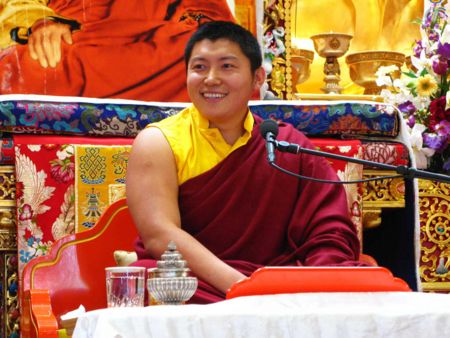
เป็นผู้สืบทอดการปฏิบัติสาย ชกจูร์ ลิงปะ (Chok Gyur Lingpa Lineage) แห่งนิกายญิงมา-ปะ (Nyingma School of Early Translation) ซึ่งเป็นนิกายโบราณของพุทธศาสนาวัชรยาน ท่านสืบเชื้อสายมาจาก ชกลิง ริมโปเช (His Eminence Chokling Rinpoche) และ ดีเชน ปาลดรอน (Dechen Paldron) เกิดเมื่อปี พ.ศ. 2525 ที่ประเทศเนปาล ท่านเดินทางเผยแผ่พุทธศาสนาในหลายๆประเทศ ซึ่งเอกลักษณ์ในการถ่ายทอดคำสอนของท่านมีลักษณะตรงไปตรงมา และเข้าใจง่าย
ตำแหน่งปัจจุบัน
• ผู้ครองบัลลังก์สายการปฏิบัติ “ รีโวเช ตักลุง การ์จู (Riwoche Taklung Kagyu Lineage) ” แห่งวัดรีโวเช (Riwoche Monastery)
• วัชราจารย์ของวัดกาญิง เชดรุป (Vajra Master: Ka-Nying Shedrub Ling Monastery) ที่ โพธนาถ (Boudhanath) เมืองกาฐมัณฑุ ประเทศเนปาล
• เจ้าอาวาสวัดโดงัก ญีดา ซุงเทรล เชดรุป รัลตรี (Abbot of Do-ngak Nyida Zungdrel Shedrab Raldri Ling Monastery) ประเทศเนปาล
• เจ้าอาวาสวัดปัล การ์จู เชดรุป ตาชี ทาเกย์ พุนสก (Abbot of Pal Kagyu Shedrub Tashi Dhargye Phuntsok Ling Monastery) ประเทศเนปาล
• ประธานของ รังจุง ยีชี เช็นเปน (President of Rangjung Yeshe Shenpen) อันเป็นองค์กรการกุศล เพื่อช่วยเหลือผู้ยากไร้ และผู้ด้อยโอกาสด้านการศึกษาและสาธารณสุขในประเทศเนปาล
• ศาสตราจารย์วิชาพุทธปรัชญา (Professor of Buddhist Philosophy) ที่สถาบันรัง จุง ยีชี (Rangjung Yeshe Institute Shedra) ศูนย์พุทธศาสนศึกษา (Center of Buddhist Studies) มหาวิทยาลัยกาฐมัณฑุ (Kathmandu University) ประเทศเนปาล ท่านสอนพุทธปรัชญาทั่วไปโดยเฉพาะอย่างยิ่งปรัชญามาธยมิกะ (The Middle Way)
การศึกษา
• ได้รับวุฒิทางการศึกษาระดับ “เคนโป (mKhan po)” ซึ่งเทียบเท่าปริญญาเอก (Ph.D.) ทางศาสนาวิทยา (Doctor of Divinity) จากองค์สมเด็จดาไลลามะที่ 14 (His Holiness 14th Dalai Lama) และจาก จงซาร์ เคียนเซ ริมโปเช (H.E. Dzongzar Khyentse Rinpoche)
• จบการศึกษาหลักสูตรพุทธปรัชญาที่สถาบันการศึกษาพุทธศาสนาชั้นสูงจงซาร์ (Dzongsar Institute of Advanced Buddhist Studies) ที่ เมืองบีร์ (Bir) มณฑลหิมาจัล (Himachal Pradesh) ประเทศอินเดีย (India) ซึ่งเน้นการศึกษาด้านคำสอนของ สายสาเกียปะ กับ เคนเชน กุงกา วังชุก ริมโปเช (Khenchen Kunga Wangchuk Rinpoche) และ จงซาร์ เตียนเซ ริมโปเช (H.E. Dzongsar Khyentse Rinpoche) ซึ่งท่านใช้เวลาในการศึกษาเพียง 7 ปี จากเวลาปกติ 9 ปี
งานเผยแผ่
• วิทยากรรับเชิญบรรยายธรรม ณ ศูนย์ปฏิบัติธรรมหลายแห่งทั่วโลก อาทิ ประเทศเดนมาร์ก ประเทศเยอรมันนี ประเทศออสเตรีย ประเทศสวิสเซอร์แลนด์ ประเทศเบลเยี่ยม ประเทศสหรัฐอเมริกา ประเทศแคนาดา ประเทศอเมริกา ประเทศอเมริกาใต้ และ ประเทศแถบเอเซียตะวันออกเฉียงใต้ ฯลฯ
• ผู้ก่อตั้งศูนย์ปฏิบัติธรรมหลายแห่งในประเทศมาเลเซีย
Kyabgon Phakchok Rinpoche is a lineage holder of the Profound Treasures of Chokgyur Lingpa from the Nyingma School of Early Translation and throne-holder of Riwoche Taklung Kagyu Lineage.
Currently duties
• Vajra Master of Ka-Nying Shedrub Ling Monastery (in Boudhanath Kathmandu, Nepal)
• Abbot of Pal Do-Ngak Nyida Zungdrel Mindrol Norbuling Monastery (Nepal)
• Abbot of Pal Kagyu Shedrub Tashi Dhargye Phuntsok Ling Monastery (Nepal)
• President of Rangjung Yeshe Shenpen Nepal, a volunteer-based, non-profi t organization that serves the poor and disadvantaged in Nepal
• Professor of Buddhist Philosophy, Rangjung Yeshe Institute Shedra, Center of Buddhist Studies, Kathmandu University, where he teaches general Buddhist philosophy with emphasis on the Middle Way
Education
Phakchok Rinpoche received the Khenpo title (similar to a Doctor of Divinity) from H.H. 14th Dalai Lama and H.E. Dzongsar Khyentse Rinpoche. He completed in seven years the traditional nine-year curriculum of Buddhist philosophy at the Dzongsar Institute of Advanced Buddhist Studies, Bir, Himachal Pradesh, India, where he specialized in studies of the Sakya School of Tibetan Buddhism under the guidance of Khenchen Kunga Wangchuk Rinpoche and H.E. Dzongsar Khyentse Rinpoche.
An enthusiastic and vibrant young teacher, Phakchok Rinpoche’s lectures are direct and easily understood. Since 1999 he has served as Professor of Buddhist Philosophy at the Rangjung Yeshe Institute Shedra, Center of Buddhist Studies, Kathmandu University, where he teaches general Buddhist
philosophy with emphasis on the Middle Way. He has also been guest-lecturer at numerous centers in Europe, North America, South America, and South East Asia.
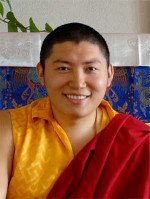 Greetings Everyone,
Greetings Everyone,
I hope you’ve all been well and happy. It’s almost midnight here in the foothills of the Himalayas and before the next day rolls in, I want to send you a little information about my whereabouts before this Guru Rinpoche day ends.
As mentioned in my last message, today is the first day of the pilgrimage and in order to mark the auspiciousness of this day, we are in Lumbini, the birthplace of Gautama Buddha. A pilgrimage is an important act of devotion and faith as it enables us to accumulate merit and purify our defilements and obscurations of the body, speech and mind by the power of the blessings of the sacred sites.
The Buddha said:
“Monks, after my passing away, if all the sons and daughters of good family and the faithful, so long as they live, go to the four holy places, they should go and remember: here at Lumbini the enlightened one was born; here at Bodhgaya he attained enlightenment; here at Sarnath he turned twelve wheels of Dharma; and here at Kushinagar he entered parinirvana. Monks, after my passing away there will be activities such as circumambulation of these places and prostration to them….. a pilgrimage to them [the four places] will help to purify their previously accumulated negative karmas, even the five heinous actions….”
Along with the four holy places we’ll be visiting other sacred sites as well and during the entire pilgrimage, I’ll think of you all and make multiple aspirations for your happiness and wellbeing.
Before I say my goodbye, I want to remind you all to constantly practice bodhicitta based on a pure motivation defined by the union of both compassion and wisdom. As mentioned by Dza Patrul Rinpoche in his Words of My Perfect Teacher, bodhicitta can be viewed as having different levels. He mentions that the highest level is that of the shepherd, who makes sure that all his sheep arrive safely ahead of him and places their welfare before him. Next is the path of the boatman, who ferries his passengers across the river and then ferries himself back. And finally the lowest is that of the way of the king who primarily thinks of his own benefit but who recognizes that his benefit depends crucially on that of his kingdom and his subjects.
Thinking of all you on this GRD and wishing you all a very merry Christmas and a very happy New Year.
Sarva Mangalam,
Phakchok Rinpoche

Kyabgon Phakchok Rinpoche visit to Bangkok in January 2011
Details in English can be found below as well as at Little Bangkok Sangha www.littlebang.org
สมเด็จพักชกริมโปเช บรรยายธรรม มกราคม 2554
For synopsis of the lecture program
บทความย่อของธรรมบรรยายกรุณาดูที่
https://www.mongkol.org/phakchok-rinpoche/kyabgon-phakchok-rinpoche-visit-jan-2011-synopsis/
เสาร์ 15 มกราคม
1330-1630 ธรรมบรรยาย เมตตาและกรุณาในพุทธศาสนา และ พิธีอภิเษกมนตรา พระอวโลกิเตศวร ณ สวนโมกข์กรุงเทพ ข้างสวนรถไฟ
แผนที่ http://littlebang.org/2010/12/31/hhpcr-sat-15th-january-bia/
อาทิตย์ 16 มกราคม
1230-1500 พิธีอภิเษกมนตรา พระไภษัชยคุรุ (พระพุทธเจ้าบรมครูแห่งยารักษาโรค) ณ วัดทรงธรรมกัลยาณี ตำบลพระประโทน จังหวัดนครปฐม
แผนที่ http://littlebang.org/2010/12/31/hhpcr-sun-16th-jan-wat-songtam-kalyani/
จันทร์ 17 มกราคม
0900-1130 ธรรมบรรยายและบูชาพระไภษัชยคุรุ ณ ม.มหิดล ศาลายา อ.พุทธมณฑล จ.นครปฐม วิทยาลัยศาสนศึกษา ห้องประชุมนานาชาติ ชั้น 2
แผนที่ http://www.crs.mahidol.ac.th/eng/contact.htm
1800-2030 ธรรมบรรยาย “หนทางสู่ความสุขใจ” ณ โรงแรมตวันนา ถ.สุรวงศ์
แผนที่ http://littlebang.org/2010/12/31/hhpcr-mon-17th-jan-tavana-hotel/
อังคาร 18 มกราคม
1800-2030 ธรรมบรรยาย “วิธีขจัดอารมณ์ที่ไม่ปรารถนา” (ภาษาอังกฤษ ไม่มีแปลไทย) ณ โรงแรมตวันนา ถ.สุรวงศ์
แผนที่ http://littlebang.org/2010/12/31/hhpcr-tue-18th-jan-english-only/
พุทธ 19 มกราคม
1000-1500 ธรรมบรรยาย “การฝึกจิต” ณ ม.ราชภัฏสวนสุนันทา ชั้น 5 อาคารศูนย์วิทยบริการ เขตดุสิต กรุงเทพฯ (ผู้เข้าร่วมต้องนำอาหารกลางวันมาเอง)
แผนที่ http://www.ssru.ac.th/app/front/home/popup_map.php
1900-2100 ธรรมบรรยาย “แก่นแท้แห่งวิถีพระโพธิสัตว์” ณ DMG อาคารอัมรินทร์พลาซ่า
แผนที่ http://littlebang.org/2010/12/31/hhpcr-wed-19th-jan/
พฤหัสบดี 20 มกราคม 1900-2100 ธรรมบรรยาย “ธรรมะจากมหาคุรุแห่งอินเดีย” (ภาษาอังกฤษ ไม่มีแปลไทย) ณ สยามสมาคม แยกอโศก
แผนที่ http://littlebang.org/2010/12/31/hhpcr-thrs-20th-jan-siam-society/
ศุกร์ 21 มกราคม
1200-1400 ธรรมบรรยาย “โพธิจิต – หนทางสู่การตรัสรู้” ณ อาคาร CP สีลม
แผนที่ http://littlebang.org/2010/12/31/hhpcr-fri-21-jan-cp-tower/
เสาร์ 22 – อาทิตย์ 23 มกราคม
ปฏิบัติสมาธิกับท่านริมโปเช เต็มสองวัน ณ ศาลาแดงเพลส ซอย ศาลาแดง หลังโรงแรมดุสิตธานี ถ.สีลม กรุงเทพฯ (ต้องค้างคืนและลงทะเบียนล่วงหน้า) ติดต่อคุณราม 0819855564 หรือ ติดต่อเราที่นี่
*ข้อมูลอาจมีการเปลี่ยนแปลง กรุณาติดตามที่ www.mongkol.org
For full information in English with maps please check:
http://littlebang.org/2010/12/30/phakchok-rinpoche-bkk-schedule/
All talks in English and Thai except specifically mentioned:
Saturday 15th Jan
1330-1630 Loving Kindness and Compassion in Buddhism with Avalokiteshvara (Chenrezig) empowerment @ Suan Mok Krungthep, next to Mo-chit BTS station
Location map: http://littlebang.org/2010/12/31/hhpcr-sat-15th-january-bia/
Sunday 16th Jan
1000-1500 Medicine Buddha empowerment @ Bhikkhuni Dhammananda’s temple – Wat Song Dhamma Kalyani in Nakorn Pathom (must bring your own lunch)
Location details and map: http://littlebang.org/2010/12/31/hhpcr-sun-16th-jan-wat-songtam-kalyani/
Monday 17th Jan
0900-1130 Medicine Buddha Dharma talk and Puja @ Mahidol University, Salaya campus, College of Religious Studies, International Conference room on 2nd floor
Location map: http://www.crs.mahidol.ac.th/eng/contact.htm
1800-2030 The Path to a Happy Mind @ Tawana Hotel
Location map: http://littlebang.org/2010/12/31/hhpcr-mon-17th-jan-tavana-hotel/
Tuesday 18th Jan
1800-2030 How to dispel negative emotions (English only) @ Tawana Hotel
Location map: http://littlebang.org/2010/12/31/hhpcr-tue-18th-jan-english-only/
Wednesday 19th Jan
1300-1500 Mind training @ Rajabhat University – Suan Sunantha Campus, 5th floor Vithayaborikarn building, Khet Dusit, Bangkok
Location map: http://www.ssru.ac.th/app/front/home/popup_map.php
1900-2100 Essence of Bodhisattva @ DMG hall, Amarin plaza
Location map: http://littlebang.org/2010/12/31/hhpcr-wed-19th-jan/
Thursday 20th Jan
1900-2100 Enlightened Buddhist teachings of the great Indian masters (English only) @ Siam society, Asok intersection
Location map: http://littlebang.org/2010/12/31/hhpcr-thrs-20th-jan-siam-society/
Friday 21st Jan
1200-1400 Bodhicitta – The Path to Enlightenment @ CP Tower, Silom road
Location map: http://littlebang.org/2010/12/31/hhpcr-fri-21-jan-cp-tower/
Saturday 22nd – Sunday 23rd Jan
Full two days Meditation retreat @ Saladang place, Soi Saladang, Silom road, behind Dusit Thani hotel. Must reserve beforehand, number of participants is limited contact Ram at 081-9855564 or contact us here
Location: Saladang place is in the Soi Saladang just behind Dusit Thani hotel at the beginning of Silom road.
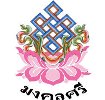


 This February 2011 well known Tibetan meditation master, Abbot, professor and writer Ringu Tulku Rinpoche will be teaching at various venues around Thailand. Be sure not to miss this eminent teacher who is well known for his erudition and excellent communication in English.
This February 2011 well known Tibetan meditation master, Abbot, professor and writer Ringu Tulku Rinpoche will be teaching at various venues around Thailand. Be sure not to miss this eminent teacher who is well known for his erudition and excellent communication in English.
 Greetings Everyone,
Greetings Everyone,